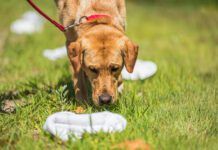by Nancy Kerns
There is no evidence that dogs can contract “mad cow disease” from eating food that was made from the rendered remains of an infected cow, say authorities from the U.S. Food and Drug Administration (FDA) and the Canadian Food Inspection Agency (CFIA). Nor is there any evidence that people could contract the disease from a dog who ate dry dog food made from infected meat.
These concerns spread like wildfire among dog owners upon hearing the news that the rendered remains of a Canadian cow determined to have bovine spongiform encephalopathy (BSE) ended up in dog food sold in the U.S. Humans cannot contract BSE. However, evidence suggests that a similar human disease, variant Creutzfeldt-Jakob Disease (vCJD), a degenerative, fatal brain disorder first seen in 1994, can be caused by eating beef products contaminated with central nervous system tissue of BSE-infected cattle. There is no evidence that dogs can contract BSE or BSE-like diseases from eating BSE-infected meat products, but some felid species (including domestic and captive wild cats) have been shown to contract BSE-like diseases from eating BSE-infected meat.
BSE was first seen in cattle in 1986. Because of the long incubation period for both BSE and vCJD (up to 10 years) and because BSE appears to have evolved as a mutation from scrapie, an endemic spongiform encephalopathy of sheep and goats, fears that the diseases could be transmitted in as-yet unknown ways and/or to new species cannot be put completely to rest.
Close to home
The eight-year-old cow at the center of the recent BSE scare was sick with pneumonia when she was slaughtered on January 31, 2003. A meat inspector from the Alberta Agriculture, Food, and Rural Development (AAFRD) department declared the cow’s carcass unfit for human consumption, and ordered a sample of the cow’s brain tissue to be taken – not because BSE was suspected (it wasn’t); routine surveillance testing for BSE calls for a certain percentage of all slaughtered cattle to be tested. The carcass was diverted to a rendering plant.
It took more than three months before the tissue sample was actually tested for BSE. On May 16, the CFIA was notified of preliminary test results indicating possible BSE; additional tests confirmed the results.
The CFIA immediately launched a two-pronged investigation to determine where the cow came from and where it went.
Looking backward
Immediately before she was slaughtered, the BSE-positive cow lived in Alberta. Investigators “depopulated” the cattle in the infected cow’s herd, as well as other herds that the cow had lived with on other ranches. (Only a test of a dead cow’s brain tissue can confirm a case of BSE.) Test results were negative for BSE in all the cattle.
The CFIA also placed 17 additional herds of cattle under quarantine: 11 herds that the infected cow lived with previously, three herds that have contained the infected cow’s offspring, and three herds that have been determined to have been fed the same feed as the infected cow. Two of the quarantined herds are located in Saskatchewan, 12 are in Alberta, and three are in British Columbia. In addition, a goat herd that may have been fed the same feed as the infected cow’s herd has also been quarantined.
Although great strides have been made to trace the BSE-positive cow to her origin, as WDJ goes to press, the mixed-breed cow’s birthplace has not yet been determined. Genetic tests are being conducted to try to determine her origin. Six years ago, Canada instituted an animal identification program that facilitates tracing food animals; this cow pre-dates the system.
None of the quarantined animals have shown any signs of the disease; however, the BSE-positive cow did not exhibit signs of BSE at time of her slaughter, either.)
Following forward
The CFIA traced the remains of the infected cow to a manufacturing plant, Champion Pet Food, in Morinville, Alberta. Initial reports from the CFIA stated that the lot of meat and bone meal containing the infected cow’s remains had ended up in chicken feed. This feed is being traced, and cattle that live on farms where the chicken feed was sent have been placed under quarantine.
Later, it was determined that the same lot of meat and bone meal had also been used in two dry dog foods for an American company, Pet Pantry International, of Carson City, Nevada, sometime between February 4, 2003, and March 12, 2003.
Pet Pantry is voluntarily recalling the foods. This action is being described as a precaution to prevent discarded dog food from getting mixed with feed for cattle, goats, or sheep; all ruminants are at risk of contracting BSE if they eat BSE-infected meat products.
Customers who purchased Canine Maintenance Diet with a “use by” date of “17FEB04” or Canine Beef with Barley with a “use by” date of “05MAR04” from Pet Pantry since February should check their supplies. If found, consumers are instructed to call the company at (800) 381-7387. The company’s foods are shipped directly to consumers, and the company is using its sales records to contact consumers.
Ready to switch to grass-fed?
The preponderance of evidence thus far suggests that cattle get BSE only by eating feed containing central nervous system tissue from infected cattle, and that most humans get vcJD by eating meat products containing BSE-infected tissues.
These facts alone make grass-fed beef that much more alluring, for both human consumption and for feeding to our dogs. To date, neither BSE nor vCJD have been seen in dogs, but less than 20 years ago, the diseases had not seen in cows or humans, either.





